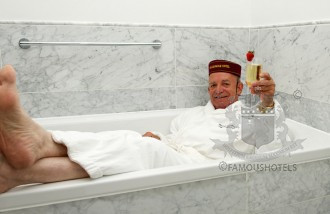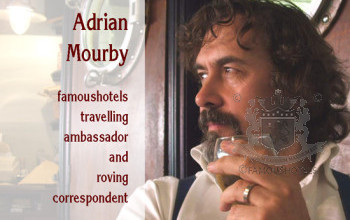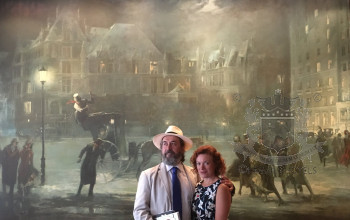Mourby of Balmoral
( words)
The Balmoral Hotel looks like a Gothic Castle perched above Norloch, the swampy ground beneath Edinburgh castle that once acted as its moat - and eventually became Waverley Station. The hotel appears to cling to the edge of a cliff face, but is in fact supremely stable. Indeed it is one of four massive stone buildings that anchor the North Bridge in place. This huge, graceful iron structure – an Edinburgh icon if ever there was one - was opened in 1897 to link the old and new towns of the Scottish capital together.
The other three corners of the bridge are held in place by the Carlton Hotel, the offices of the Scotsman newspaper (now the Scotsman Hotel) and Edinburgh’s old Post Office. After the Castle itself, no view better represents Edinburgh than North Bridge.
When it was completed in 1902, the Balmoral was known as the North British Station Hotel. It was built to serve passengers arriving by train into Waverley Station along the East Coast main line from London and Berwick on Tweed.
The massive clocktower that surmounts the hotel has always run three minutes fast to hasten on those with trains to catch. Still today the only occasion when it runs accurately is on New Year’s Eve when Hogmanay party-goers in Edinburgh count down the seconds to New Year with their eyes on the Balmoral.
I first came to stay here in the early 1980s when it was still known as the North British, and a giant Scotsman in tartan would meet you at the revolving door. As a BBC producer I was one of many media types invited to the Edinburgh International Festival and we were all given a huge breakfast in the Palm Court Lounge.
The old North British was on its last legs then. British Rail, the UK’s nationalised railway company, was selling off its collection of majestic hotels. In 1983 the North British Station Hotel passed to the Gleneagles Hotel Company. It then had a chequered career: closed in 1988 for a £23-million refurbishment, bought in 1990 by Balmoral International Hotels, an Edinburgh-based company, and reopened in 1991 as their flagship under its new name, the Balmoral Hotel - and then sold off again.
*
Although the name Balmoral has royal connections and a solid Gaelic provenance ( it means “majestic dwelling” in the Scottish tongue), the name change was probably not a wise move. The North British (or NB has it had been known locally for decades) had a long and glorious past. It had hosted everyone from Laurel and Hardy to Sophia Loren, from the Burton-Taylors to the (Linda) McCartneys plus Queen Elizabeth the Queen Mother, and British prime ministers, Edward Heath and Harold Wilson.
You can throw away a lot of history when you change a name but over the past 25 years Edinburgh has learned to embrace The Balmoral, particularly after Sir Rocco Forte purchased - some might say rescued - it in 1997 and made it the first hotel in what is now the Rocco Forte Collection of excellent historic hotels. As ever the interiors were given a stylish makeover by his designer sister Olga Polizzi, mistress of the giant chair and gargantuan vase.
Visiting the hotel for the first time in years I notice how it has responded well to an increased sense of national self-awareness that is everywhere in Scotland following the recent Independence debate. There is a Sir Walter Scott Suite named after the author who did so much to make Scotland fashionable in the nineteenth century. There are black and white prints of Sir Sean Connery in bedrooms on the 4th, 5th and 6th floor that commemorate the great Edinburgh actor who reopened the hotel in 1991. And Room 552 where Edinburgh author J K Rowling finished writing the Harry Potter series has been renamed the J K Rowling Suite. Her presence is marked by an antique bust of Hermes that she signed.
There is also a new bar to complement the energetic, international Balmoral Cocktail bar. "Scotch" is decorated in calming, dark clubland colours and hosts the largest collection of single malt whiskies available to the general public in Edinburgh (The Scotch Malt Whisky Society in Queen Street has more, but it’s a private members club). Scotch contains at least one single malt from every current distillery in Scotland - and a few from those who are no longer with us. Here designers have responded to the Balmoral’s quest to represent Scotland not only in its early twentieth-century glory but in the twenty-first century too. The bar’s four whisky “ambassadors” who are on hand to educate the drinking public are dressed in modern kilts made from the Balmoral’s own tartan. I was told they each designed his own sporran.
As for the Palm Court Lounge were I breakfasted back in the 1980s, it has been returned to something closer to a drawing room of 1902 but with much great delicacy in its colour scheme and furnishings than the Edwardian original we observe in hotel photographs. A traditional harpist plays as you eat your cream tea but the armchairs have that certain contemporary Olga-swagger about them.
*
Hotels embarking on their second century of life are inevitably also historical artefacts and questions arise continually about how one updates that history so that the hotel can still earn its living as a functioning 21st century business. At the Balmoral however, those quandaries are magnified by the issue of how one also reflects the Scottish nation in a hotel that has symbolised the capital city since its completion in 1902. And do so without becoming a national cliché, especially now as Scotland itself seems to be changing very rapidly.
However I think the Balmoral is doing a good job, getting it more right than wrong and still proving a delight to stay in.
And the giant on the door: He still wears tartan but today he greets you in something much subtler, somehow a more 21st century tartan than the one I remember from the days of the North British Station Hotel.
The other three corners of the bridge are held in place by the Carlton Hotel, the offices of the Scotsman newspaper (now the Scotsman Hotel) and Edinburgh’s old Post Office. After the Castle itself, no view better represents Edinburgh than North Bridge.
When it was completed in 1902, the Balmoral was known as the North British Station Hotel. It was built to serve passengers arriving by train into Waverley Station along the East Coast main line from London and Berwick on Tweed.
The massive clocktower that surmounts the hotel has always run three minutes fast to hasten on those with trains to catch. Still today the only occasion when it runs accurately is on New Year’s Eve when Hogmanay party-goers in Edinburgh count down the seconds to New Year with their eyes on the Balmoral.
I first came to stay here in the early 1980s when it was still known as the North British, and a giant Scotsman in tartan would meet you at the revolving door. As a BBC producer I was one of many media types invited to the Edinburgh International Festival and we were all given a huge breakfast in the Palm Court Lounge.
The old North British was on its last legs then. British Rail, the UK’s nationalised railway company, was selling off its collection of majestic hotels. In 1983 the North British Station Hotel passed to the Gleneagles Hotel Company. It then had a chequered career: closed in 1988 for a £23-million refurbishment, bought in 1990 by Balmoral International Hotels, an Edinburgh-based company, and reopened in 1991 as their flagship under its new name, the Balmoral Hotel - and then sold off again.
*
Although the name Balmoral has royal connections and a solid Gaelic provenance ( it means “majestic dwelling” in the Scottish tongue), the name change was probably not a wise move. The North British (or NB has it had been known locally for decades) had a long and glorious past. It had hosted everyone from Laurel and Hardy to Sophia Loren, from the Burton-Taylors to the (Linda) McCartneys plus Queen Elizabeth the Queen Mother, and British prime ministers, Edward Heath and Harold Wilson.
You can throw away a lot of history when you change a name but over the past 25 years Edinburgh has learned to embrace The Balmoral, particularly after Sir Rocco Forte purchased - some might say rescued - it in 1997 and made it the first hotel in what is now the Rocco Forte Collection of excellent historic hotels. As ever the interiors were given a stylish makeover by his designer sister Olga Polizzi, mistress of the giant chair and gargantuan vase.
Visiting the hotel for the first time in years I notice how it has responded well to an increased sense of national self-awareness that is everywhere in Scotland following the recent Independence debate. There is a Sir Walter Scott Suite named after the author who did so much to make Scotland fashionable in the nineteenth century. There are black and white prints of Sir Sean Connery in bedrooms on the 4th, 5th and 6th floor that commemorate the great Edinburgh actor who reopened the hotel in 1991. And Room 552 where Edinburgh author J K Rowling finished writing the Harry Potter series has been renamed the J K Rowling Suite. Her presence is marked by an antique bust of Hermes that she signed.
There is also a new bar to complement the energetic, international Balmoral Cocktail bar. "Scotch" is decorated in calming, dark clubland colours and hosts the largest collection of single malt whiskies available to the general public in Edinburgh (The Scotch Malt Whisky Society in Queen Street has more, but it’s a private members club). Scotch contains at least one single malt from every current distillery in Scotland - and a few from those who are no longer with us. Here designers have responded to the Balmoral’s quest to represent Scotland not only in its early twentieth-century glory but in the twenty-first century too. The bar’s four whisky “ambassadors” who are on hand to educate the drinking public are dressed in modern kilts made from the Balmoral’s own tartan. I was told they each designed his own sporran.
As for the Palm Court Lounge were I breakfasted back in the 1980s, it has been returned to something closer to a drawing room of 1902 but with much great delicacy in its colour scheme and furnishings than the Edwardian original we observe in hotel photographs. A traditional harpist plays as you eat your cream tea but the armchairs have that certain contemporary Olga-swagger about them.
*
Hotels embarking on their second century of life are inevitably also historical artefacts and questions arise continually about how one updates that history so that the hotel can still earn its living as a functioning 21st century business. At the Balmoral however, those quandaries are magnified by the issue of how one also reflects the Scottish nation in a hotel that has symbolised the capital city since its completion in 1902. And do so without becoming a national cliché, especially now as Scotland itself seems to be changing very rapidly.
However I think the Balmoral is doing a good job, getting it more right than wrong and still proving a delight to stay in.
And the giant on the door: He still wears tartan but today he greets you in something much subtler, somehow a more 21st century tartan than the one I remember from the days of the North British Station Hotel.










